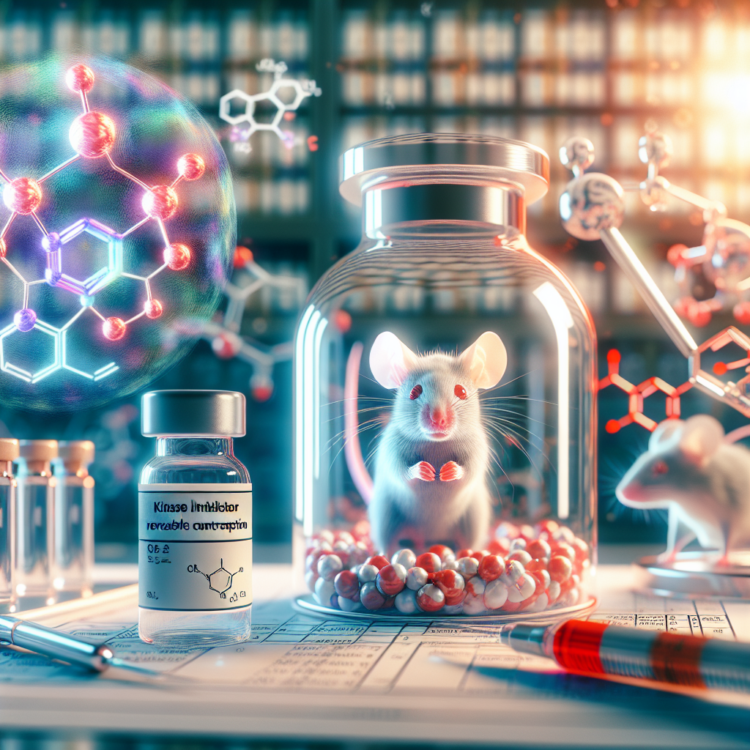An inhibitor that targets the kinase STK33 – a protein essential for male fertility in humans and mice – effectively induces reversible infertility in male mice without toxicity or other adverse effects on reproductive function, researchers report. The findings underscore the potential of STK33 as a druggable target, offering a promising avenue for the development of nonhormonal and reversible male contraceptives. Contraception is crucial for family planning, allowing individuals to choose if and when to conceive and how many children to have. However, advancements in contraception have been limited in recent decades, particularly for men. Currently, there are no effective oral contraceptives for men. Although hormonal-based approaches for male contraception are being investigated in clinical trials and have shown some promising results, none have been approved for general use. Nonhormonal targets present a promising avenue with potentially fewer side effects. However, few small-molecule nonhormonal inhibitors have been developed, and even fewer have demonstrated contraceptive efficacy in preclinical models. The homozygous serine/threonine kinase 33, also called STK33, is essential to male fertility. Previous studies have shown that mutations to STK33, in both mice and men, result in infertility due to defective sperm motility and morphology without other significant health issues, suggesting STK33’s use as a viable target for male contraception. To identify STK33-specific inhibitors, Angela Ku and colleagues performed a large-scale drug screening using a multibillion-compound collection of DNA-encoded chemical libraries. After uncovering several potent STK33-specific inhibitors, Ku et al. obtained crystal structures of STK33 with some of the identified compounds and used the information to assist in structure-guided molecule design. One of the most promising compounds – CDD-2807 – was shown to reduce fertility in vivo in male mice. According to the findings, CDD-2807 exhibited no toxicity, efficiently crossed the blood-testis barrier, did not accumulate in the brain, and induced a contraceptive effect that mirrored genetic STK33 perturbations without altering testis size. Importantly, Ku et al. found that the inhibitor’s contraceptive effects were reversible, and mice recovered their fertility soon after the treatment was discontinued. “Any potential contraceptive drug must undergo extensive testing to show very high efficacy and rule out adverse effects on hormone levels, overall reproductive function, and impact on offspring. Additionally, long-term studies are necessary to evaluate potential risks associated with prolonged use,” write Jerrett Holdaway and Gunda Georg in a related Perspective. “Nevertheless, the findings substantiate the essential role of STK33 in male fertility and provide compelling evidence that this target is druggable and results in reversible male infertility.”
An inhibitor that targets the kinase STK33 – a protein essential for male fertility in humans and mice – effectively induces reversible infertility in male mice without toxicity or other adverse effects on reproductive function, researchers report. The findings underscore the potential of STK33 as a druggable target, offering a promising avenue for the development of nonhormonal and reversible male contraceptives. Contraception is crucial for family planning, allowing individuals to choose if and when to conceive and how many children to have. However, advancements in contraception have been limited in recent decades, particularly for men. Currently, there are no effective oral contraceptives for men. Although hormonal-based approaches for male contraception are being investigated in clinical trials and have shown some promising results, none have been approved for general use. Nonhormonal targets present a promising avenue with potentially fewer side effects. However, few small-molecule nonhormonal inhibitors have been developed, and even fewer have demonstrated contraceptive efficacy in preclinical models. The homozygous serine/threonine kinase 33, also called STK33, is essential to male fertility. Previous studies have shown that mutations to STK33, in both mice and men, result in infertility due to defective sperm motility and morphology without other significant health issues, suggesting STK33’s use as a viable target for male contraception. To identify STK33-specific inhibitors, Angela Ku and colleagues performed a large-scale drug screening using a multibillion-compound collection of DNA-encoded chemical libraries. After uncovering several potent STK33-specific inhibitors, Ku et al. obtained crystal structures of STK33 with some of the identified compounds and used the information to assist in structure-guided molecule design. One of the most promising compounds – CDD-2807 – was shown to reduce fertility in vivo in male mice. According to the findings, CDD-2807 exhibited no toxicity, efficiently crossed the blood-testis barrier, did not accumulate in the brain, and induced a contraceptive effect that mirrored genetic STK33 perturbations without altering testis size. Importantly, Ku et al. found that the inhibitor’s contraceptive effects were reversible, and mice recovered their fertility soon after the treatment was discontinued. “Any potential contraceptive drug must undergo extensive testing to show very high efficacy and rule out adverse effects on hormone levels, overall reproductive function, and impact on offspring. Additionally, long-term studies are necessary to evaluate potential risks associated with prolonged use,” write Jerrett Holdaway and Gunda Georg in a related Perspective. “Nevertheless, the findings substantiate the essential role of STK33 in male fertility and provide compelling evidence that this target is druggable and results in reversible male infertility.”
Journal
Science
Article Title
Reversible male contraception by targeted inhibition of serine/threonine kinase 33
Article Publication Date
24-May-2024




